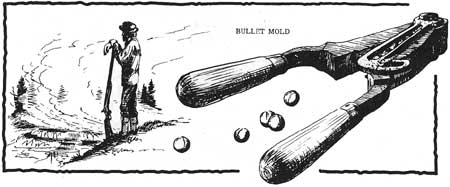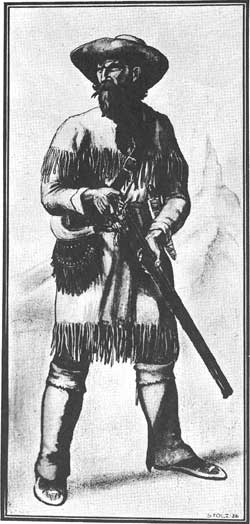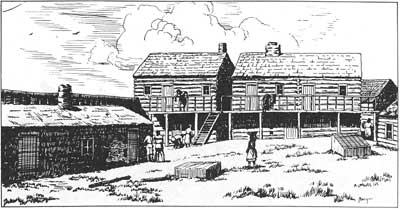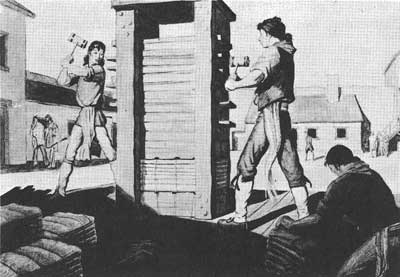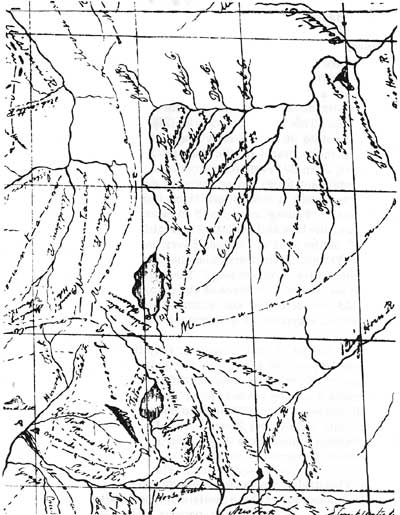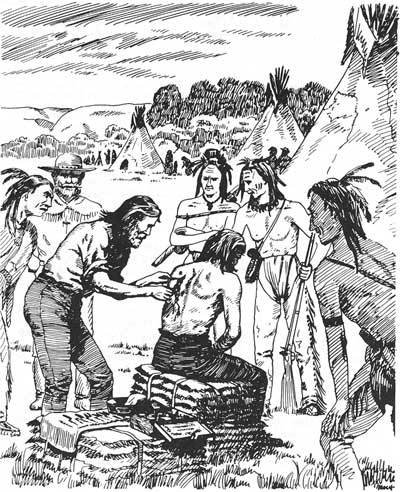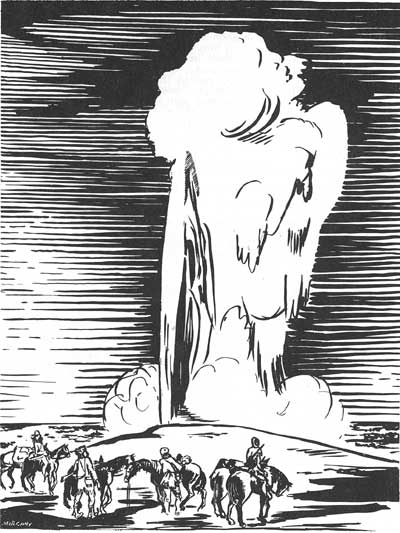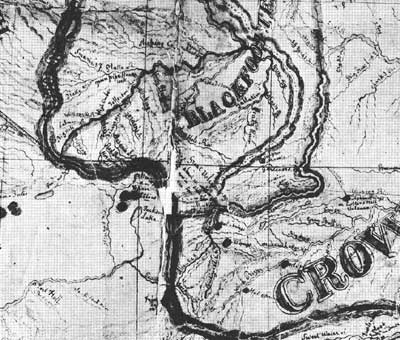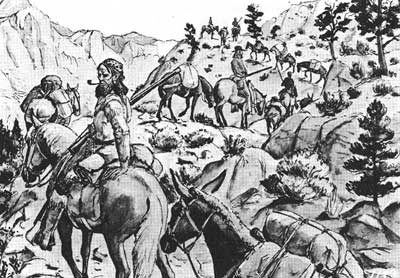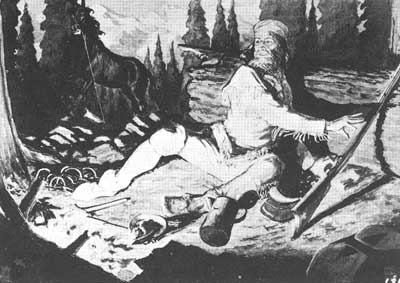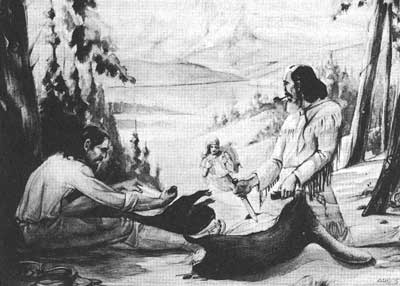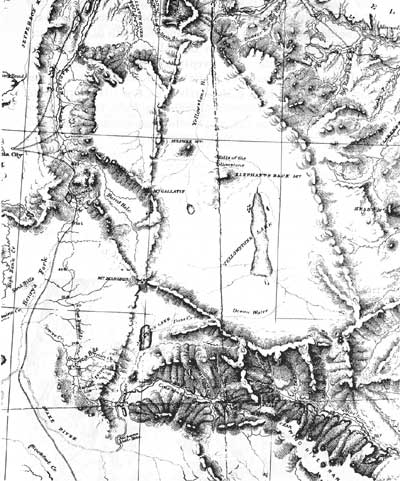|
Grand Teton National Park |

|
Yellowstone National Park |
|
VII. "The Fire Hole": Era of the American Fur Company, 1833-1840 By 1832 only fragments of the Yellowstone Park area had apparently been explored, notably the Lake region. According to Warren A. Ferris, one of the great geyser basins was visited in the spring hunt of 1833 by a party of forty men under a Spaniard named Alvaris (or Alvarez). They reached the area by going up Henry's Fork, later returning to Green River for the rendezvous. This is the first concrete evidence of white men in the Firehole Basin. The discoverer may have been Manuel Alvarez, United States consul at Santa Fe from 1839 to 1846, who figures prominently in Josiah Gregg's journal. The rendezvous of 1833 was held at Bonneville's fort on Horse Creek, tributary of Green Riven, near Daniel, Wyoming. The St. Louis supply caravan of the Rocky Mountain Fur Company, led by Robert Campbell, included young Charles Larpenteur, who wrote in his journal of a side trip through Jackson's Hole:
An epidemic of hydrophobia brought on by "mad wolves" seems to have contributed to the early break-up of the 1833 meeting. Campbell, Wyeth, and the partners of the Rocky Mountain Fur Company with fifty-five packs of beaver and a strong guard circled down through South Pass and up to the junction of the Shoshone and the Bighorn rivers, where they embarked on bullboats for the mouth of the Yellowstone. Here Wyeth was entertained at the palatial Fort Union by the famous Kenneth McKenzie, and observed a powder flask which had belonged to the unfortunate More, and which had found its way here from Jackson's Hole by the devious channels of the fur trade.
While Bonneville outfitted an expedition under Joseph R. Walker to explore California (and discover Yosemite Valley), the American Fur Company brigades headed for the Snake River country. On July 20 Warren A. Ferris and Robert Newell departed at the head of an outfit destined for the Flathead trade. The little party consisted of six "engages" with pack horses, and five armed Indians, amounting in all to thirteen armed men. Their route was the usual one via Hoback Canyon and Teton Pass. The ecstatic description of Jackson's Hole from the summit of the pass, given by Ferris on this occasion is one which can be appreciated by the modern tourist:
The rendezvous of 1834 was scheduled for June on Ham's Fork of the Green near present Granger, Wyoming; and here converged all the scattered trapper bands, with the exception of those in the pay of Bonneville, who had his own private rendezvous on Bear River. Drips hunted up the Snake River to Jackson's Hole, and apparently crossed into the valley of the Green from there. Behind him came Ferris. On his southward journey from Montana country, Ferris decided to make a side trip from Henry's Fork to investigate strange rumors concerning the upper Madison, a trip which resulted in the second known published description of the Yellowstone Park wonders. Ferris, a native of New York who later resided in Texas, made his first western journey with the American Fur Company in 1830. Hardly a typical mountain man, he kept a journal of his travels entitled "Life in the Rocky Mountains," which appeared serially in 1842 and 1843 in the Western Literary Messenger, an obscure weekly published in Buffalo, New York. The piece containing an account of his visit to the geyser region in 1834 appeared on July 13, 1842, attracted no special attention at the time except that of the editors of the Nauvoo, Illinois, Wasp, who ran it with out credit in their edition of August 13, 1842. Olin D. Wheeler discovered it and republished it in 1901. Its historical importance as the first adequate description of the geysers by an eyewitness (and the second published description of any portion of Yellowstone Park) was appreciated by Chittenden, but his identity and the magnificent scope of his journal was not fully understood until its republication with extensive editorial notes by Dr. Paul C. Phillips in 1940. It was in May 1834, while his brigade was traveling through Idaho country en route to the rendezvous on Ham's Fork of the Green, that Ferris and two Indian companions made a hurried side trip, going almost due east forty miles. His object was to verify the rumors concerning "remarkable boiling spring on the sources of the Madison" which he had heard at the rendezvous of 1833. He soon realized that "the half was not told me." A fragment of his vivid description follows:
After this adventure, he returned to Henry's Fork and thence to Pierre's Hole, crossing Teton Pass on May 24. In the Hoback Canyon he found evidence that a party under Drips had preceded him. Less well known than the vivid description by Ferris but even more remarkable is his "Map of the Northwest Fur Country," drawn in 1836. Lying in the family trunk for over a century, unknown to geographers and historians, it was made available in 1940 for publication with the journals. This is, to quote Dr. Phillips, "the most detailed and accurate of all the early maps of the region," far superior in accuracy to the famous maps by Bonneville, Parker, John C. Fremont, and others which were published contemporaneously. In addition to mountain chains, valleys, and trails, it locates such fascinating details as "Yellowstone L.," "Boiling water," and "Volcanoes" near the south shore of the lake and "spouting fountains" within the "Burnt Hole" at the head of Madison River, indicating the present West Thumb thermal area and the Upper Geyser Basin on Firehole River, respectively. The context of the journal, together with the evidence of the map, suggests that Ferris beheld and described Old Faithful, the geyser which has become the symbol of Yellowstone National Park. In August of 1834 a party of fifty-five men in Bonneville's employ led by Joseph H. Walker ascended Pacific Creek from Jackson's Hole and after some debate "agreed to move down onto Wind River," instead of descending the Yellowstone. Thus Walker, who had previously discovered Yosemite Valley, and Zenas Leonard, the journalist of the expedition, missed the big exploring opportunity which Ferris had grasped.
The quaint nomenclature bestowed on certain locales and landmarks by the mountain trappers offer more than one clue to their shadowy passage. The Gardner River Valley at Swan Lake Flats, between Mammoth Hot Springs and Obsidian Cliff, seems to be the most likely locale of the beaver-rich "Gardner's Hole" frequented by the mountain men, probably named for Johnson Gardner, a freelance trapper who must have frequented those parts at least as early as 1834, possibly as early as 1830 as Chittenden suggests. His name appears in the Fort Union account books of 1832, which include an agreement to purchase his stock of beaver skins then cached on Yellowstone River. In 1834 he fell in with Prince Maximilian of Wied on the Lower Missouri, revealing to that distinguished traveler that "he was on his return from hunting beavers on the Upper Yellowstone." Three significant events occurred in connection with the rendezvous of 1834. (1) En route from St. Louis, Sublette and Campbell began the building of Fort Laramie (originally Fort William) on the North Platte. (2) Nathaniel Wyeth, embarking on a second venture, brought in trade goods which were not accepted, and so resorted to the establishment of Fort Hall near the junction of the Snake and Portneuf. The advent of these two fixed trading posts prophesied an end to the traditional rendezvous system. Also (3), at the rendezvous the partnership of the Rocky Mountain Fur Company was dissolved, Fraeb and Gervais selling out their interests. The remaining partners—Fitzpatrick, Bridger, and Milton Sublette—formed a new firm, but they made an agreement with Fontenelle which gave the American Fur Company a virtual monopoly of the Rocky Mountain fur trade. Among those whom Nathaniel Wyeth had left at Fort Hall in 1834 was a young man named Osborne Russell, whose subsequent career as a trapper was hardly typical, for among his trapping accessories were copies of Shakespeare and the Bible! Although later a prominent pioneer of Oregon and California, his claim to fame rests on his Journal of a Trapper, which "as a precise and intimate firsthand account of the daily life of the trapper explorer . . . has no equal," except that of Warren A. Ferris, who left the mountain scene just as Russell arrived. On the 15th of June 1835 a party of fourteen trappers and ten camp keepers was made up. Writes Russell:
After a nearly disastrous attempt to cross "Lewis Fork" by bullboat and raft, the party discovered a ford, and then ascended Gros Ventre Fork. The party became lost in the mountains for several weeks, missing out on the Green River rendezvous. After extricating themselves from the craggy wilderness of the Absarokas, the party reached the Lamar River on East Fork of the Yellowstone, where they encountered some woebegone Sheepeater Indians, and lost a hunter. They apparently forded the Yellowstone at the lower end of the Grand Canyon near the mouth of Antelope Creek, at a point just above the spectacular Tower Falls and the Basaltic Cliffs where the river "rushes down a chasm with a dreadful roar echoing among the mountains." From "Gardner's Hole" the party then crossed the mountains to Gallatin and Madison forks, where they fell in with a trapping brigade under Bridger. Just below the Madison Canyon the combined forces were attacked by eighty Blackfeet and narrowly escaped massacre. The supply caravan under Fitzpatrick arrived at the Green River rendezvous on August 12, 1835. Accompanying him were two famous missionaries—Marcus Whitman, who distinguished himself among the trappers by extracting an Indian arrow from the back of Captain Bridger, and Reverend Samuel Parker, who alienated them by his overzealous moralizing. However, Parker made quite a hit with the assembled Flatheads and was so enthusiastic over their eagerness for Christian knowledge that it was decided that he would accompany them to their homes, while Whitman would return to the states to recruit help for a permanent mission in Oregon. Parker tells of his journey westward:
According to the impious Joseph L. Meek, the sermon on Sunday the 23rd in Jackson's Little Hole (the site of which has been memorialized by the State of Wyoming as that of "the first Protestant sermon in the Rocky Mountains") was not such a great success as Parker makes out, for, "in the midst of the discourse, a band of buffalo appeared in the valley, when the congregation broke up, without staying for a benediction," and every man excitedly joined in the hunt. Another who accompanied this expedition was Kit Carson. Parker gave Carson his initial shove into immortality by relating the story of his victory at the rendezvous oven a "great bully" named Shunar:
Another rendezvous was held for the summer of 1836, again on Horse Creek tributary of Green River. Fitzpatrick and Fontenelle arrived with the supply caravan on July 3. with them were the missionaries Marcus Whitman and H. H. Spalding, accompanied by their wives, the first white women ever to attend a rendezvous of the mountain men and doubtless the first to come within 100 miles of the future Grand Teton and Yellowstone Parks. At this meeting Major Joshua Pilcher, as agent for the American Fur Company, formally and legally took over the interests of Bridger, Fitzpatrick, and Fontenelle, thus consolidating the monopoly. The missionaries, accompanied by Hudson's Bay Company agents, followed the Bear River route westward. The fur trappers were left in the mountains with Drips, Fontenelle, and Bridger. Says Osborne Russell
Russell entered Jackson's Hole by way of the upper Green and Gros Ventre rivers, followed the Snake River north to Jackson Lake, and on August 7 started up Buffalo Fork, to reach Two Ocean Pass. On August 13, he camped at the inlet of Yellowstone Lake, and on the 16th "Mr. Bridger came up with the remainder of the party." They followed along the eastern shore of the lake to its outlet at present Fishing Bridge, and camped again "in a beautiful plain which extended along the northern extremity of the lake." Russell describes the lake as "about 100 miles in circumference . . . lying in an oblong form south to north, on rather in the shape of a crescent." His further description of the boiling springs, hot steam vents, and the hollow limestone crustation "of dazzling whiteness," apparently in Hayden Valley, ranks him with Potts and Ferris as a pioneer journalist of the Park phenomena.
In 1837 Thomas Fitzpatrick again led the supply train across the plains, picking up Fontenelle at Fort Laramie, and arriving at the rendezvous on July 18. After the business of that year was transacted, Drips returned east with Fitzpatrick's caravan, and Fontenelle and Bridger made up a strong company of 110 men to invade the hostile Blackfoot country. Osborne Russell and five others started off separately "to hunt the headwaters of the Yellowstone, Missouri and Bighorn Rivers." Going due north up Green River, they were attacked by "sixty or seventy" Blackfeet, but managed to escape to the rendezvous. Here they wisely decided to throw in with Fontenelle's party, as Russell explains, "intending to keep in their company five or six days and then branch off to our first intended route." After descending the Hoback, Russell and three others left the main party at the ford of "Lewis Fork" in "Jackson's Big Hole" and took the same route to Yellowstone Lake used the preceding year, then went northeast over the mountains to gain the "Stinking Water." In the spring of 1838 the company moved westward from Powder River, trapping the Bighorn and other tributaries of the Yellowstone. Russell and Meek report another fight with the Blackfeet on the Madison, followed by a gathering of the brigade on the north fork of the Yellowstone, near the lake. Afterward, Meek reports:
Osborne Russell describes this rendezvous of 1838:
The Captain Stewart referred to by Russell was an English veteran of Waterloo, Sir William Drummond Stewart, ostensibly a wealthy sportsman, who became a perennial visitor to the annual conclaves of the "mountain men," beginning in 1833. He probably entered Jackson's Hole on more than one occasion, in company with the trapper bands, but of this there is no proof, except the following passage to be found in Altowan, a romantic novel based on his experiences:
By 1838, competition for beaver pelts was beginning to exhaust the streams, and the law of diminishing returns was making itself felt in the Rocky Mountain fur trade. Nevertheless, after the rendezvous of that year, the field commanders of the company assembled their trappers for an other invasion of the Jackson's Hole country. Again Osborne Russell illuminates the scene:
Russell's side trip appears to have been made cross country from near the Cottonwood Creek tributary of the Gros Ventre over the foothills of Mt. Leidy to Spread Creek, where he set traps, then back along this same route to Bridger's camp on the Gros Ventre, then back to Spread Creek, and later down the Snake River, rejoining the main camp near the mouth of the Gros Ventre. Russell's account of the main expedition fits in very well with the brief entry in Newell's diary—"up Wind River into Jackson's Hole, on to Pier's Hole. Another trapper present was young Jim Baker, famous Wyoming pioneer, who was making his first visit to the mountains. An entry in Russell's journal indicates that a party of trappers from Fort Hall reached Yellowstone Lake in 1838. Meek alleges that he went alone to Gardner's Hole after the rendezvous and later to Burnt Hole, the neighborhood of Hebgen Lake. Here he left a joking message on a buffalo skull. Some evidence of wintering in Jackson's Hole is given by Robert Newell:
Kit Carson writes:
In March, Meek, after wintering among the Nez Perces on the Salmon River, and acquiring an Indian wife (apparently his third), set out trapping again with a comrade named Allen to whom he was much attached.
Correlated with other data, the "pass which leads to Pierre's Hole" sounds very much like Teton Pass. Here, according to Victor, a horrible event occurred. Ambushed by Blackfeet, Meek managed to escape in a thicket, but the hapless Allen was caught, shot, and then gleefully dismembered within sight and sound of his companion. Meek is supposed to have wriggled away during the night and, "after twenty-six days of solitary and cautious travel," escaped to the place of rendezvous. Information on the rendezvous of 1839 has survived through the account of F. A. Wislizenus, a German doctor and political refugee, who accompanied the St. Louis supply train in the interests of curiosity and recreation. In addition to offering a vivid picture of proceedings at the rendezvous, he also coments on the decline of the fur trade in the Rocky Mountains. Wislizenus, Ermatinger of the Hudson's Bay Company, the Munger-Griff in missionary party, and several hundred Indians left the rendezvous for Fort Hall, going by the Bear River route, which was soon to become a part of the Oregon Trail. As for the trappers, it appears that some of them, yielding to fate, disbanded, but Meek and Newell were among those who went to Fort Hall and later trapped around Brown's Hole (a valley made by the Green River along the northern base of the Uinta Range). Others were still attracted to Jackson's Hole, the heart of the prime beaver country. An eminent pioneer of Montana, W. T. Hamilton, got it from "old-timers" that:
This party was attacked by the Blackfeet near the outlet of Yellowstone Lake, suffering a loss of five men. The survivors, while trapping the Park, witnessed "Sulphur Mountain," the Mud Volcano, Yellowstone Falls at the head of the Canyon, and the pyrotechnic displays of "Fire Hole Basin." Early in 1839, Russell hunted mountain sheep and trapped beaver along the Snake River below Jackson's Hole, returning to Fort Hall in June. Making up a party of four for the purpose of trapping in the Yellowstone and Wind River Mountains, he spent the Fourth of July at the outlet of Jackson Lake, near present Moran, then followed the Snake River northward to Lewis Lake and Shoshone Lake. The Shoshone Geyser Basin is described by Russell in meticulous detail, including the rhythmic "Hour Spring" which resembles present Union Geyser. From here they crossed over to Hayden Valley via the Midway Geyser Basin, there noting a "boiling lake" of deep indigo blue, about three hundred feet in diameter, probably the present Grand Prismatic Spring. After an extended camp at the outlet of Yellowstone Lake they went east to the head of Clark's Fork, thence back to the Yellowstone at the ford near Tower Falls, thence to Gardner's Hole and back to the lake outlet. En route they saw disturbing evidence of "a village of 300 or 400 lodges of Blackfeet" that had only recently been evacuated. In their camp on Pelican Creek, just east of the present Fishing Bridge campground, they were suddenly assailed by a horde of "70 or 80" Blackfeet "who rent the air with their horrid yells" and inflicted severe arrow wounds on Russell and one other. They fought off the Indians with their rifles, but suffered great pain and hardship in making their way back to Fort Hall via West Thumb, Snake River, Berry Creek and Conant Pass at the north end of the Teton Range. This was Russell's final sorrowful exit from Wonderland. Two slim and shaky clues to other Yellowstone expeditions in the late 1830's are available. In his journal of 1889, while sojourning in the Utah country, apprentice trapper E. Willard Smith reports: "The country around the head waters of the Yellowstone, a tributary of the Missouri, abounds in natural curiosities. There are volcanoes, volcanic productions and carbonated springs. Mr. Vasquez told me that he went to the top of one of these volcanoes, the crater of which was filled with pure water, forming quite a large lake." In his Life in the Far West (1849), a fictionalized account of the mountain men, with whom he had personally consorted in 1846, Lieutenant Ruxton tells how, on one occasion, Old Bill Williams, "tough as the parfleche soles of his moccasins," led seven of his hardy associates into a little-known region, beckoned thence by "a lofty peak" which fits the description of the Grand Tetons, entering "the valley lying about the lakes now called Eustis and Biddle, in which are many thermal and mineral springs, well known to the trappers by the name of Soda, Beer, and Brimstone Springs, and regarded by them with no little awe and curiosity, as being the breathing places of his Satanic majesty."
The year 1840 can be said to mark the formal demise of the Rocky Mountain fur trade, for in that year was held the fifteenth and last of these great conclaves of the wilderness, the trapper's rendezvous on Horse Creek of the Green River. It also marks the end of an epoch in the history of Jackson's Hole. The main chronicler of this fateful year was the Belgian, Pierre-Jean De Smet, a Jesuit priest who accompanied the American Fur Company's last expedition to the mountains so that he might survey the prospects for a Catholic mission among the Flathead Indians. This was the beginning of a series of epic pilgrimages to the Far West which were to make him one of the dominant figures in American frontier history. Andrew Drips headed the supply train. Also present were several Protestant missionaries and "the first avowed Oregon emigrant," Joel P. Walker, and his wife and five children. On April 30, the caravan left Westport, Missouri, and, after two months of traveling over the Great Plains in the midst of vast buffalo herds, it reached its destination. Writes father De Smet:
Joe Meek relates that,
However, this sad story does not fit in with De Smet's account nor with the testimony of Meek's own good friend, Robert Newell, who in June 1840 also left Fort Hall for the rendezvous:
Unless Meek's memory was at fault, the discrepancy can only be explained on the assumption that Meek, approaching Green River by way of Jackson's Hole, simply did not look hard enough. Be that as it may, Meek avers that after his disappointed return to Fort Hall,
What Newell had to propose to Meek was something revolutionary. On one of Newell's wagons Meek loaded his traps and his Indian family, and together they performed the historic feat of taking the first wagons through to the Columbia River. Their departure best symbolizes the death of the Rocky Mountain fur trade and the birth of the Oregon Trail. After Meek's visit in 1840, Jackson's Hole relapsed into virgin solitude. For twenty years thereafter there is little positive evidence of white men in this valley. It was forty-five years before the arrival of the first permanent settler. For over a hundred years the historic importance of Jackson's Hole as the continental crossroads of the Western fur trade has been all but forgotten.
|
|
| ||
| <<< PREVIOUS | CONTENTS | NEXT >>> |
|
Colter's Hell and Jackson's Hole ©1962, Yellowsone Association Grant Teton Natural History Association colter/chap7.htm — 05-Mar-2004 | ||
